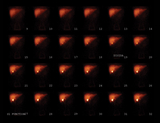DISIDA Scan (Hepatobiliary Scan)
What is a DISIDA scan?

A DISIDA scan is an exam of the gallbladder and the hepatobiliary system (the ducts connecting the gallbladder to the liver and the small bowel).
We do the test by giving your child an intravenous radiopharmaceutical. This "tracer" is medicine combined with a small amount of radioactive material. It travels to the area of your child we need to see and is detected and imaged by a gamma camera.
Radiopharmaceuticals are carefully tested. The risk of side effects is extremely small. Most radiopharmaceuticals used in nuclear medicine studies give less radiation exposure than a day at the beach.
What should you do prior to the exam?
- Your child should not receive radiographic contrast agents 24 hours prior to the bone scan.
- Your child cannot have morphine or morphine-derived medications for 24 hours prior to the scan.
- Your child must not have anything to eat or drink for four hours prior to the scan. However, you do not need to follow this step if your child has biliary atresia.
- If your child requires sedation you will receive additional instructions to follow.
- Dress your child comfortably, in clothes that are easily removed. Your child may be given a gown to change into for the procedure.
- We have a large variety of video entertainment to choose from, however, your child can also bring along a favorite movie to watch during the exam.
- You may want to bring a snack or drink for your child to have after the exam.
Note: Parents will be allowed to accompany their child into the exam room. It may be helpful to make other arrangements for siblings.
What should you expect during the exam?
- A technologist or nurse will place an IV in your child’s arm, hand or foot. Your child may feel a small pinch.
- The technologist will ask why the DISIDA scan is being done and will explain the study to you and your child.
- The technologist will inject the tracer through the IV line.
- The technologist will take a set of images. This portion of the exam will last about one hour. Your child will have to lie still. The camera will be above the table and will come close to, but will not touch your child.
- After viewing the initial images, the nuclear medicine physician may want to take more. Delayed images may need to be taken up to four hours after the initial images and in certain circumstances, possibly 24 hours.
DISIDA with CCK
Your child's physician may order a DISIDA scan with CCK (cholecystokinin); a hormone produced in the body. If so, it would begin if the one-hour images explained above show normal flow of the radiopharmaceutical.
A dose of CCK will be given to your child through the IV over a 15-minute period. The CCK will cause the gallbladder to contract. We will take images during the injection of CCK and continue for about 20 minutes after the dose is complete. During that time we are able to measure the rate at which the gallbladder empties, and determine if emptying is normal.
Sedation is an option for the delayed imaging portion of the test for young patients and for those unable to hold still.
If you’d like, our child life specialists will help you prepare and support your child during the procedure. We can also arrange to have a child life specialist at your child's appointment to explain the procedure in developmentally appropriate ways and to help your child better cope with the stress of the hospital experience.
What should you do after the exam?
There are no special instructions for your child to follow when the procedure is over.
Test results
The images from your child's exam are interpreted on the same day and a report is sent to your physician's office.
Your physician may call 215-590-2584 with questions about the exam.